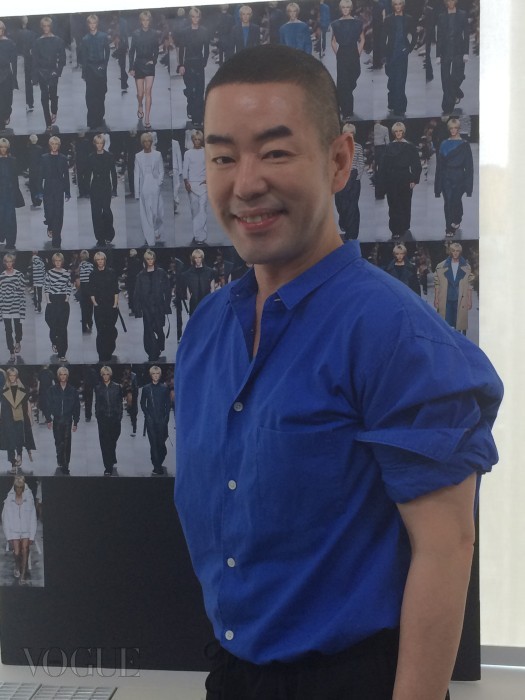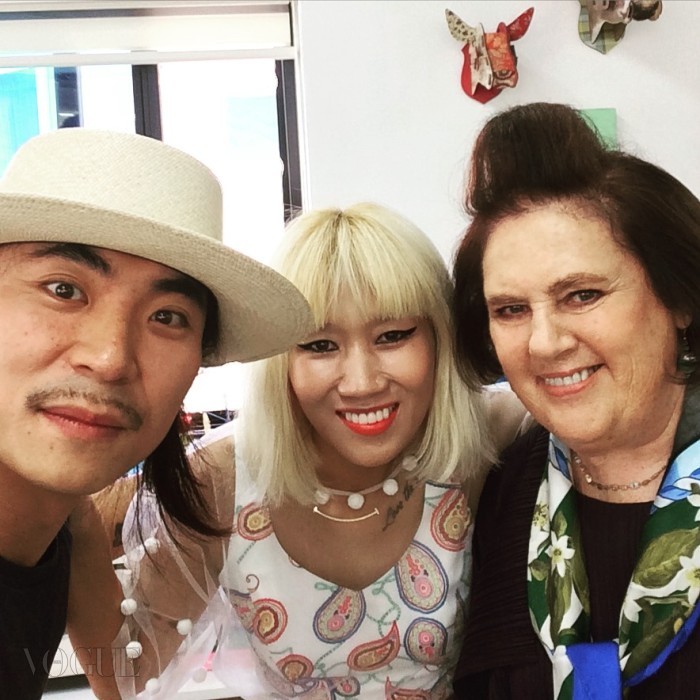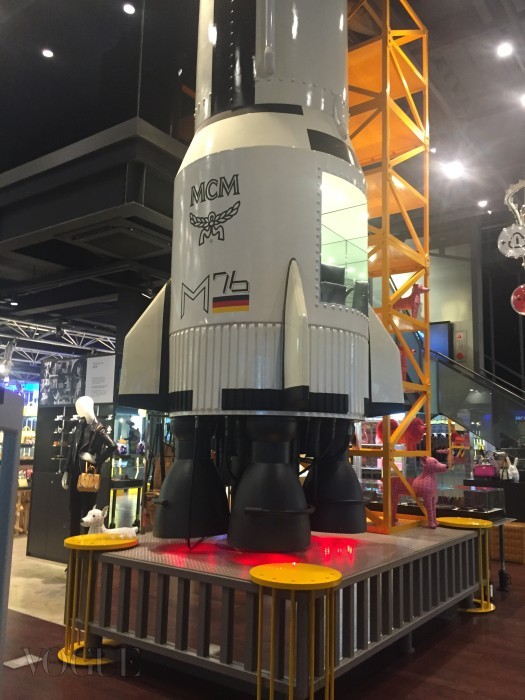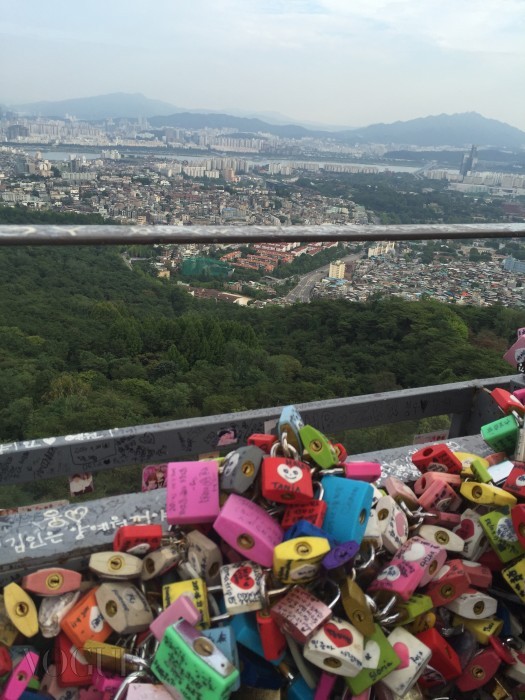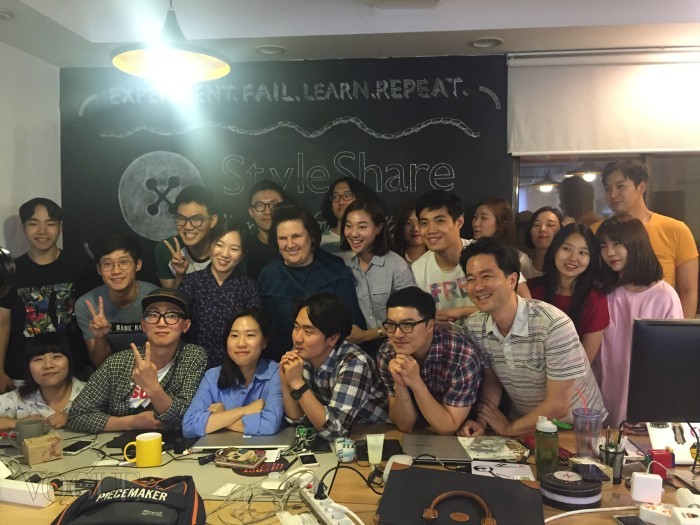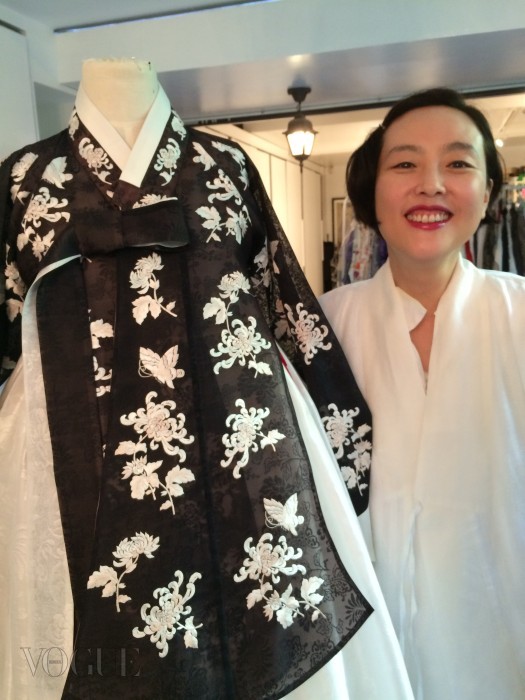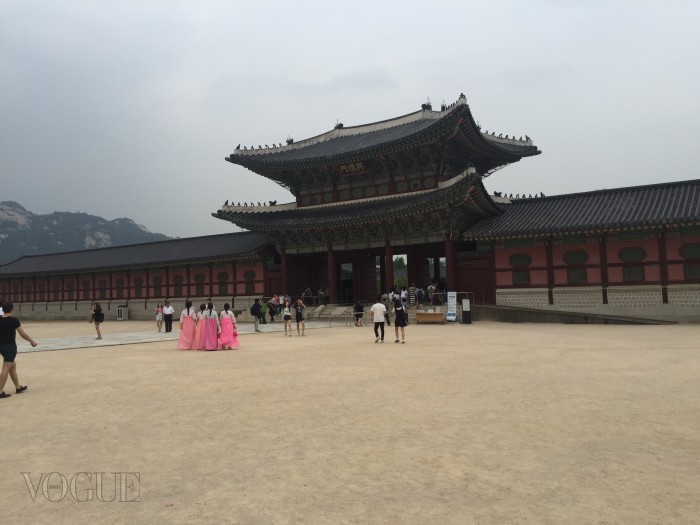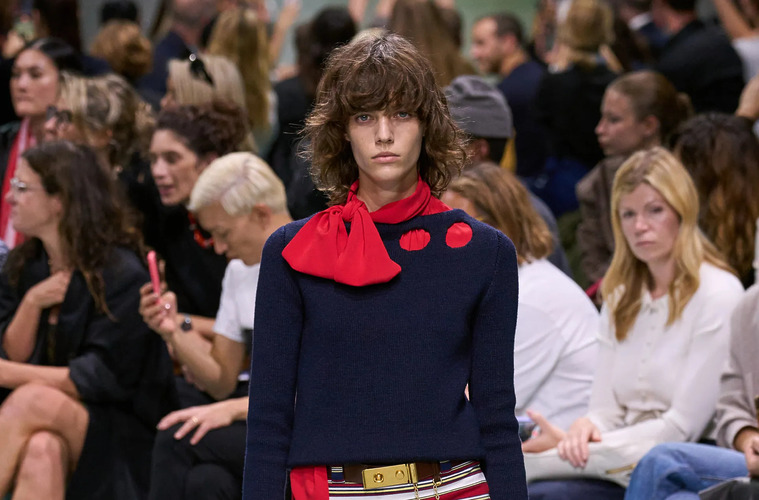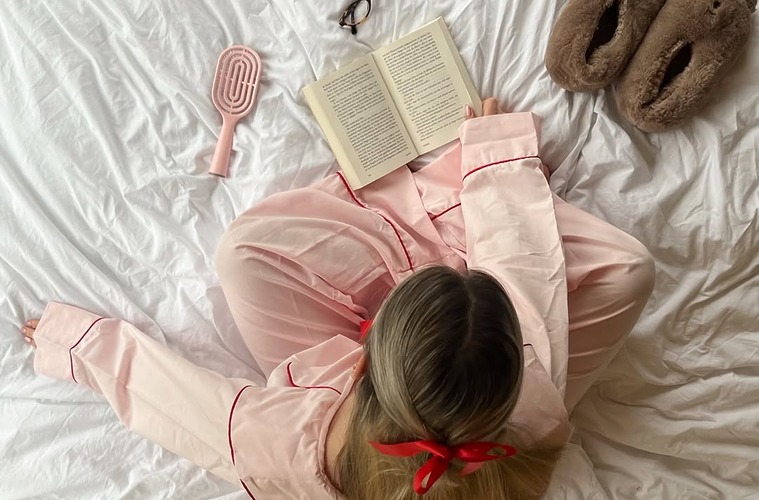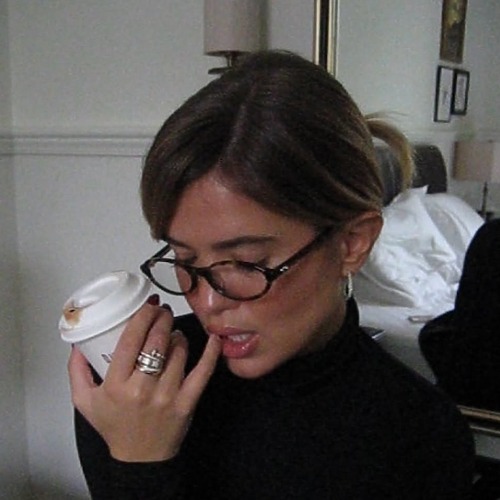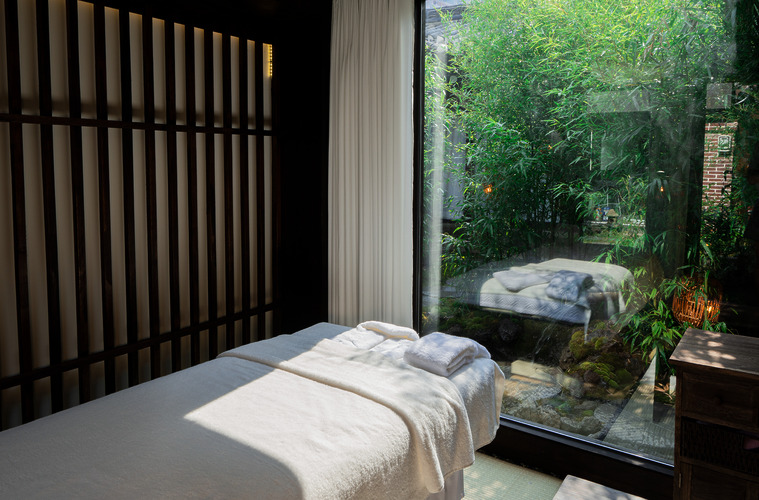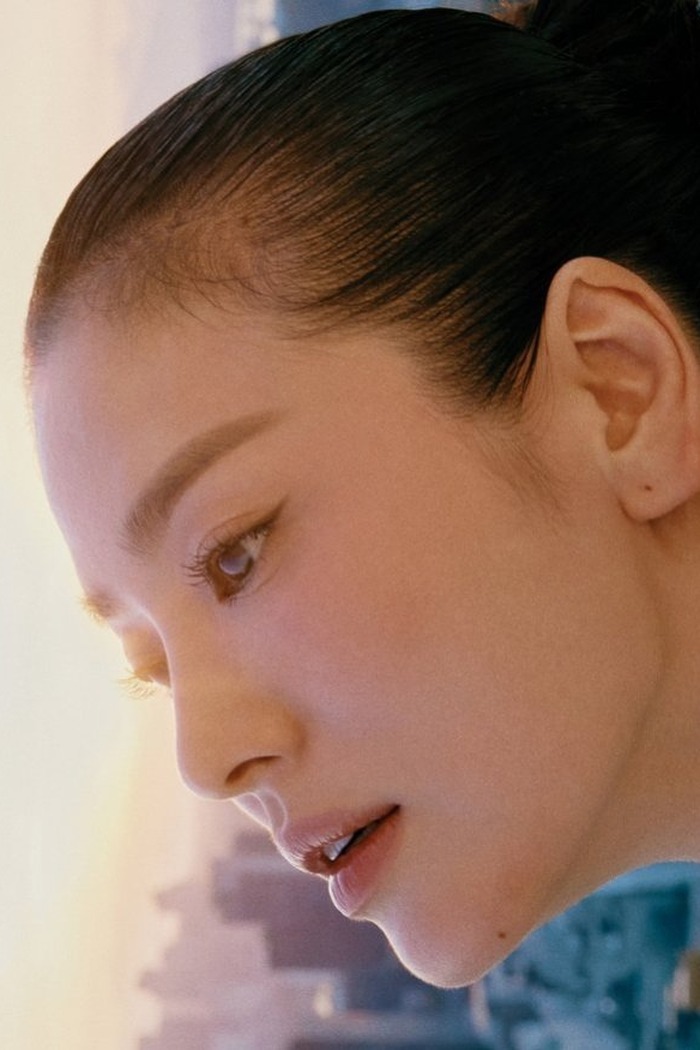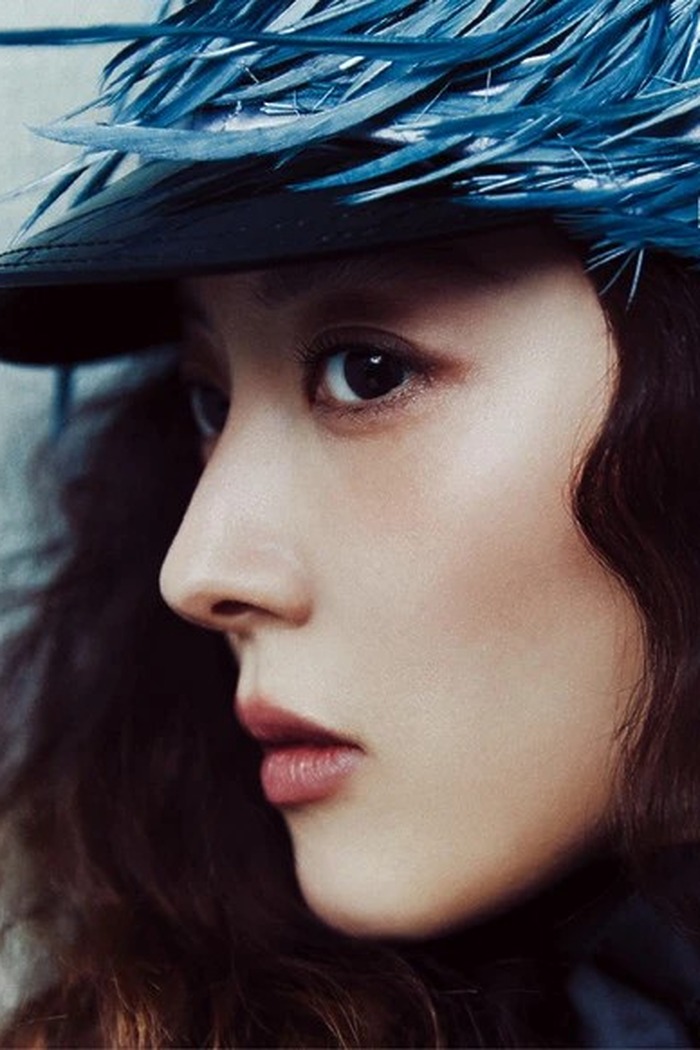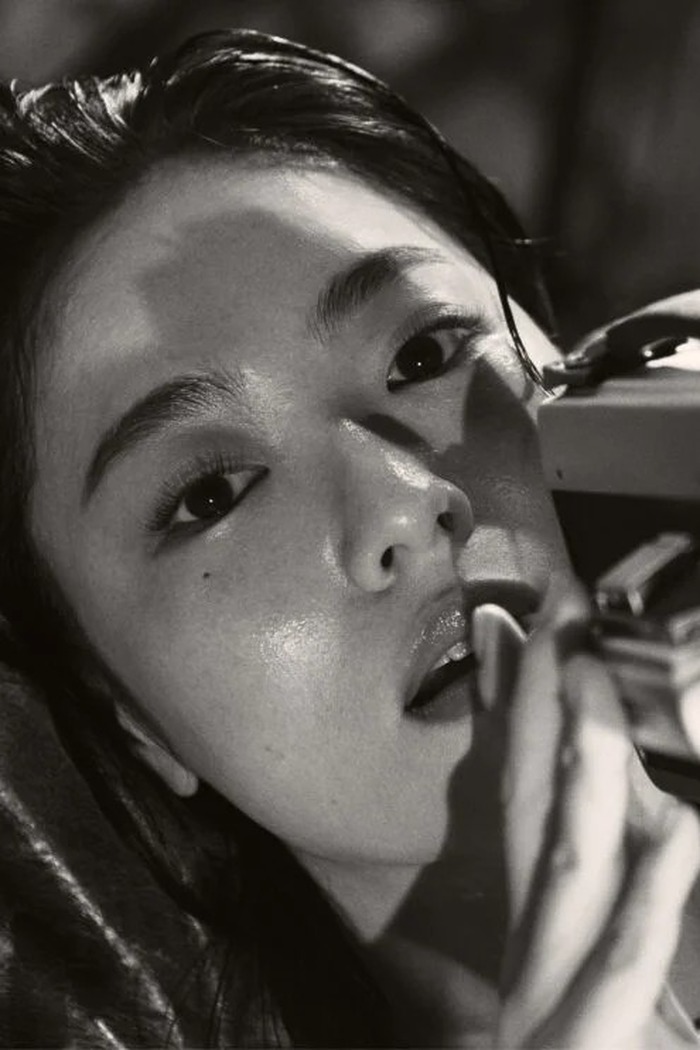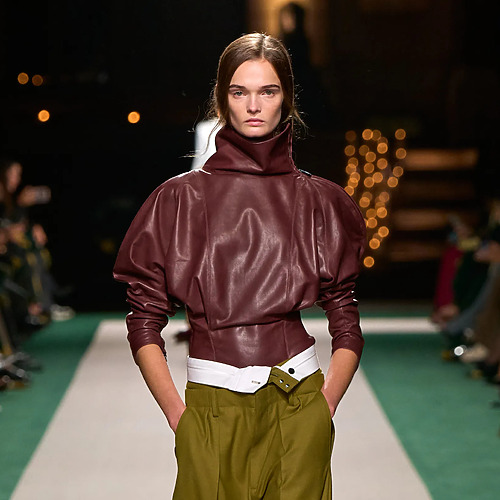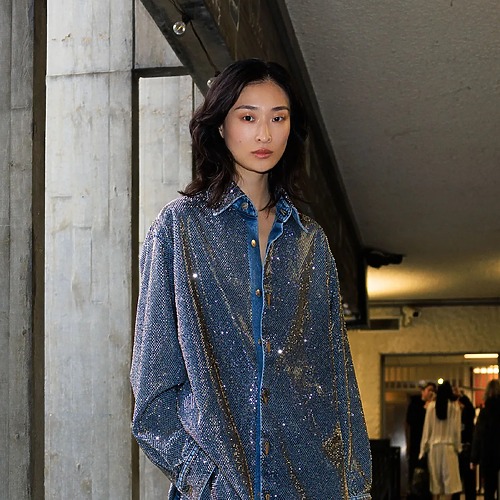K-Dreaming
나날이 피어나는 패션의 도시, 서울에서 보내는 수지 멘키스의 리포트
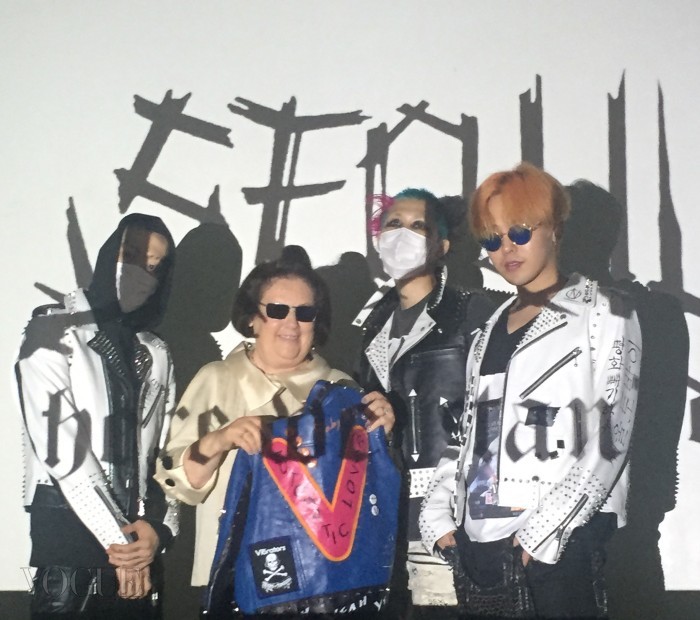
수지 멘키스가 오렌지색 머리를 한 K팝 스타 G드래곤, 핑크와 아쿠아블루 머리의 아티스트 나인티나인퍼센트이즈(99Percentis), 그리고 후드를 뒤집어쓴 분더샵의 크리에이티브 디렉터 양승호와 함께 포즈를 취하고 있다.
그들의 머리는 쇼킹한 핑크색, 오렌지색 혹은 초록색이었다. 내 눈 앞에 나타난 어느 K팝 그룹은 패션아이콘의 자태를 취하고 있었다.
한국으로의 첫 여행에서 여러 번 마주했던 순간처럼, 나는 스펙타클한 창조성에 압도당했다. 5백만 명 이상의 인스타그램 팔로워를 지닌 글로벌 스타 지드래곤, 아니 권지용은 지금 서울의 하이엔드 편집숍 분더샵에서 팝업 스토어를 위한 프로모션을 준비하고 있었다.
이 편집숍은 메르세데스 벤츠의 으르렁대는 엔진소리와 유명 브랜드 플래그숍들이 차지하고 있는 서울의 부유한 지역 한 가운데에 있었다. 이제는 2012년 입 소문을 타고 퍼져 20억 이상의 뷰를 달성한 싸이 <강남스타일> 뮤직비디오의 근거지로 세계에 알려져 있는 바로 그곳이다.
이날 오전, 나는 한 고상한 부티크 안에서 이러한 젊은이들의 반란을 이끌어낸 패션 사업가 정유경 신세계 부사장을 만났다. 그녀는 신세계 그룹이 새로운 세대를 포용하고 싶다면 급진적인 리테일의 전환이 중요하다고 주장했다.
나는 강력한 크리에이티브의 동력이자 파리 컬렉션에서의 중요한 남성복 디자이너인 정욱준과 이야기를 나눴다. 준지의 레트로 퓨처리즘 디자인은 엣지가 있으면서 21세기 세대에 호소력이 있다. 가장 최근의 컬렉션에선 데님을 선보였다. 몸에 들러붙지 않도록 만드는 정밀한 재단과 남성적인 형태를 따르려는 카멜레온적인 능력이 반영된 디자인이었다.
나는 준지가 전자제품에서 리테일까지 아우르는 초국가적 대기업 삼성으로부터 투자를 받아 2020년까지 여성복 라인을 선보이려 할 정도로 국제적으로 성공할 수 있었던 이유에 대해 물었다. “중요한 건 헌신과 사명감입니다. 저는 돈을 위해 일하는 게 아니라 정체성을 분명하게 만들기 위해 일합니다.” 정욱준이 대답했다.
글로벌한 명품거인들과 경쟁하는 토종 패션디자이너들은 중요한 에티튜드의 변화를 이뤘어야 했다. 이번 여름 샤넬과 디올 등 유럽 브랜드들은 건축가 자하 하디드가 설계한 거대한 모더니즘 건축물인 서울 동대문 디자인 플라자(DDP라는 애칭으로 알려져 있다)에서 쇼를 열기로 결정했다. 우선 칼 라거펠트는 한국에서 어느 날 밤 2015/16 샤넬 크루즈 쇼를 가졌고, 크리스챤 디올은 8월 25일까지 헤리티지 전시회 <디올 정신>을 진행한다.
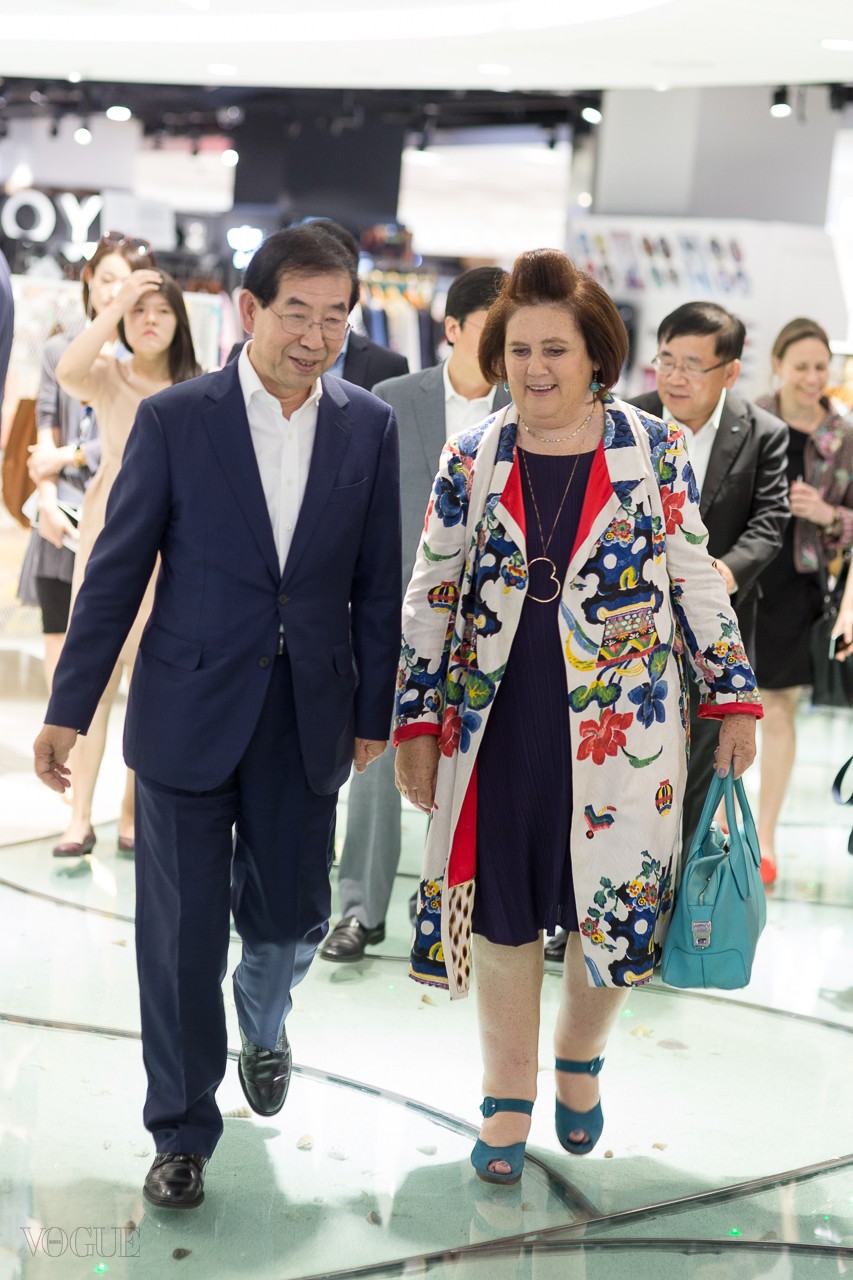
박원순 서울시장과 함께 한 두타몰 탐험
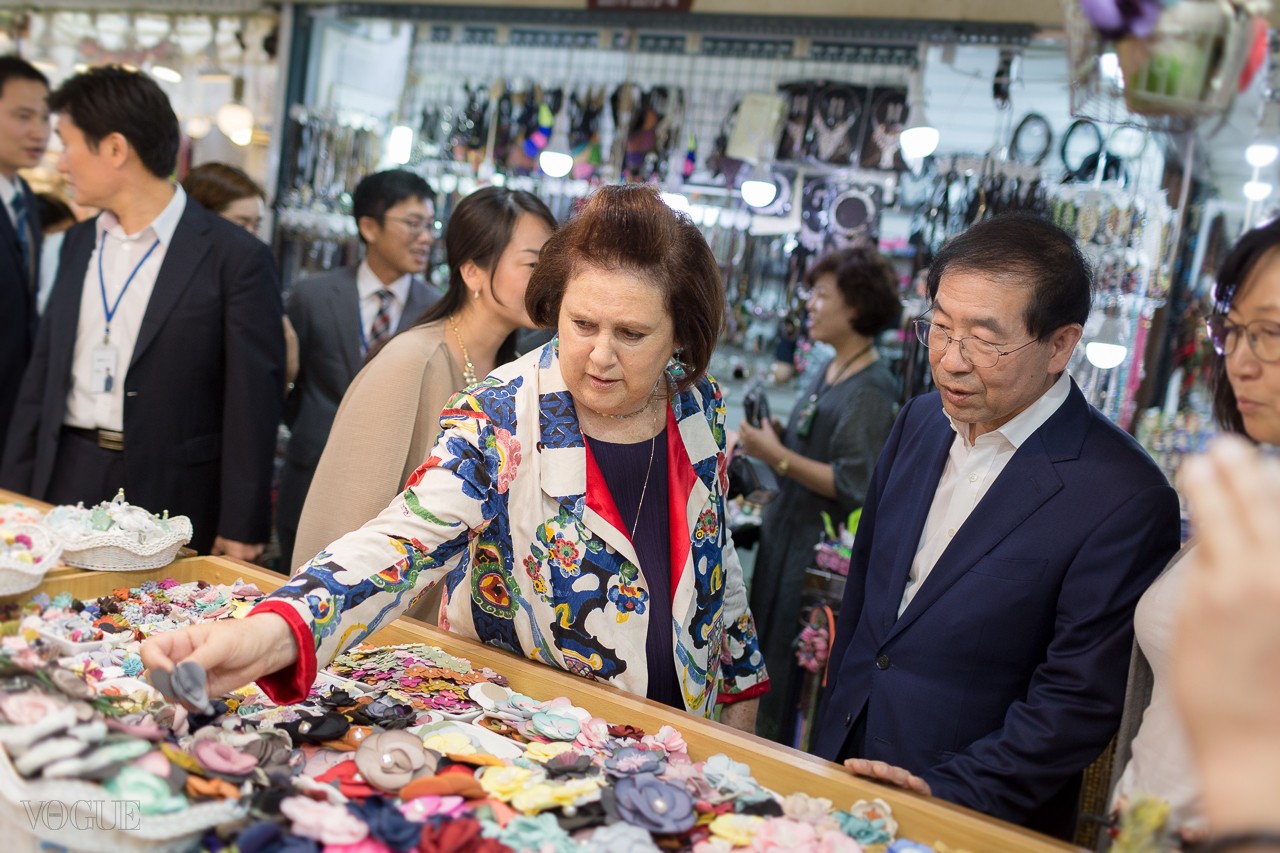
박원순 서울시장은 수지 멘키스과 함께 동대문시장을 방문했다. 이곳에선 4,300개 이상의 상점이 모여 방대한 규모의 패브릭과 잡화를 판다
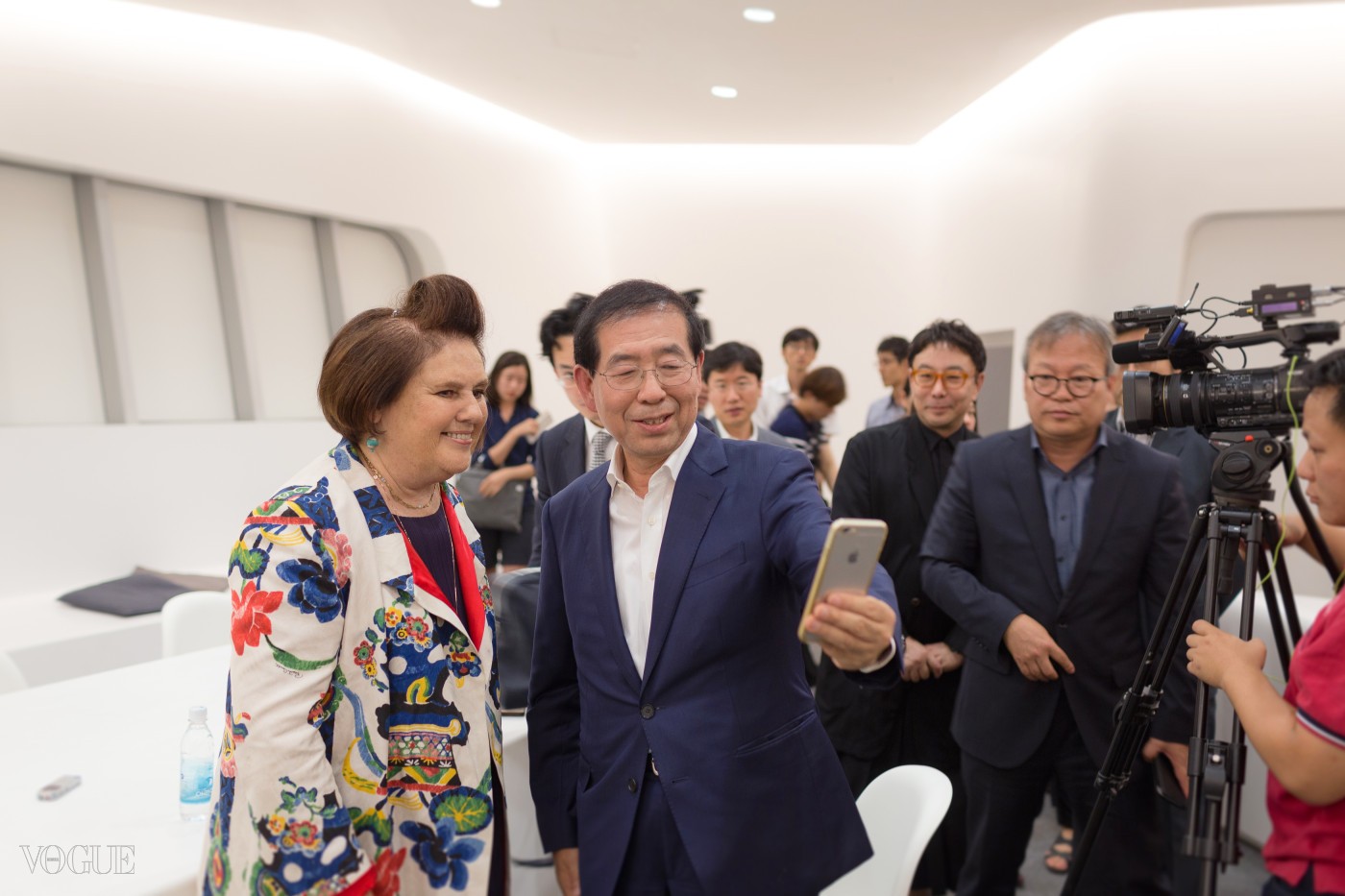
박원순 서울시장이 자하 하디드가 설계한 DDP에서 수지 멘키스와 셀카를 찍고 있다.
박원순 서울시장과 서울패션위크의 크리에이티브 디렉터로 새로 취임한 정구호에게는 이러한 질문을 던졌다. 로컬 디자이너들은 국제적인 영향력을 지닌 디자이너로 성장할 수 있을까?
나는 여러 디자이너 지망생들과 마찬가지로 영국에서 공부한 스티브 J & 요니 P 듀오와 이야기를 나눴다. 요니는 런던 칼리지 오브 패션에서, 스티브는 센트럴 세인트 마틴스에서 고(姑) 루이스 윌슨 교수의 사사를 받았다.
강남의 멋들어진 지역에 위치한 스튜디오에서 이 듀오는 서울 다운타운의 중심무대에 있는 듯 보였다. 이들은 최근 대형 의류회사와 계약을 맺음으로써 독립성을 유지하는 자유에 재정적인 뒷받침을 할 수 있을 것으로 기대하고 있었다.
또 다른 훌륭한 디자이너인 김재현은 부엉이 로고가 새겨진 럭키 슈에뜨 컬렉션에 대한 지원군을 만났다고 설명했다. 그러나 그렇기 때문에 김재현은 하이엔드 라인인 자뎅 드 슈에뜨를 접어야만 했다.
거대기업(혹은 한국말로 ‘부’와 ‘무리’를 뜻하는 ‘재벌’)으로부터 지원을 받는 일은 가능해 보였다. 특히나 삼성은 주도적인 역할을 맡고 있는 듯했다. 삼성회장의 딸인 이서현은 뉴욕 파슨즈 디자인스쿨에서 공부했고 지금은 패션과 명품을 담당하는 자회사인 제일모직에서 사장직을 맡고 있다. 이서현 사장은 변화하는 한국의 패션 씬에 대해 설명하고 있었지만, 평범하고 젊은 서울의 고객들은 누구이며 어디에 있는 걸까?
나는 스티브 J & 요니 P 주변에서 멋진 젊은이들을 보았다. 유럽 관광객들과 근처 부대에서 나온 미군들로 북적이는 이태원을 둘러보았다. 나는 한국인인 김성주 사장이 부활시킨 독일의 액세서리 브랜드 MCM 매장에 설치된 우주시대 전시를 보기 위해 중국인 관광객들이 모여든 명동거리에도 나가보았다. 나는 지방시부터 베르사체까지 모든 브랜드들이 밀집해있지만 대부분의 매출은 음식과 다이닝 구역에서 일어날듯한 롯데월드몰을 방문했다. 나는 N서울타워 꼭대기에 오르기도 했다. 서울을 둥그렇게 에워싼 작은 산 중 하나에 위치한 N서울타워에서는 젊은 연인들이 주변에 둘러진 철망에 사랑의 자물쇠를 하나 더 채운 후 하트모양의 푸른 잎이 무성한 나무 아래에 앉아 있었다.
어느 곳에 가도 젊은 사람들은 똑같이 캐주얼한 옷을 입고 있었다. 정교하게 연출된 특색 없는 정체불명의 “놈코어”가 아니라 심플하고 편안한 옷차림이었으며 가끔은 볼드한 액세서리도 함께 매치했다.
강남지역 중 한곳인 가로수길에는 좀더 깜찍한 옷차림들이 많았고 이를 보니 도쿄 하라주쿠의 일본소녀들이 떠올랐다.
‘스킨푸드’라는 로컬 숍부터 영국의 ‘러쉬’에 이르기까지 여성스러운 화장품 가게 가운데에는 한 인터렉티브 앱에서 비롯된 온라인 이모티콘을 표현한 실제 제품들을 판매하는 ‘라인 프렌즈’ 스토어가 있었다. 그러나 한창 공사 중인 폴로 랄프 로렌의 커다랗고 강렬한 매장 전면처럼, 더 거대한 브랜드들이 이미 이 거리를 점령하고 있는 것으로 보였다.
이 모든 일들을 거친 후에도 나는 여전히 패션의 ‘강남스타일’에 대한 아이텐티티를 분명히 파악하기에 어려움을 겪고 있었다.
나는 스타일쉐어(www.styleshare.co.kr)의 창립자인 윤자영과 만나면서 크게 매력을 느꼈다. 스타일쉐어는 사용자들이 전적으로 그 콘텐츠를 만들어가는 인기 있는 패션 웹사이트다. 이 플랫폼을 통해 한국 젊은이들은 자신들이 모아놓은 패션에서부터 통찰력을 얻고 전세계적으로 스타일리시한 옷차림에 대한 영감을 주고 있다.
그러나 현재 런던 센트럴 세인트 마틴스에서 공부하고 있으며 모국을 자주 방문하는 조은지 학생이 보여준 종합적인 통찰이 가장 흥미로웠다. 그녀는 현재의 중국이 한국 연예계에 열광하고 영감을 얻는 것과 마찬가지로 한국은 언제나 미국에 의지하고 있다고 설명하며 깊이 있는 분석을 보여줬다.
“한국사람들은 언제나 ‘아메리칸 드림’을 지녔었죠. 이제는 비슷해지긴 했어요. 미군이 한국에 주둔해있긴 하지만 우리는 언제나 헐리우드와 같은 문화를 가지려고 추구해왔어요.” 조은지 학생은 종합적인 문화를 만들어내기 위해 새로운 것들과 새로운 유행을 좇던 한국인들의 열정이 이제는 중국인들에게 “코리안 드림”을 만들어내고 있다고 설명했다.
조은지 학생에 따르면 K패션과 그 주변문화는 아직 중국의 역사적인 오리엔탈리즘이나 일본의 애니메이션과 같은 수준의 독특한 현대적인 개성을 만들어내지 못했다. 그러나 그녀는 한국 드라마에 등장하는 남녀 주인공의 로맨스가 한국과 중국 간의 냉랭한 관계를 녹이고 있다고 믿고 있었다. 중국의 젊은 세대들에게 한국은 여러 방면, 특히 스타일에 있어서 벤치마킹의 대상이 되고 있다.
서울 인천국제공항에서 중국말로 수다를 떨면서 면세품 비닐포장을 뜯어내어 핸드캐리 가방에 쑤셔 넣고 있는 중국여성들을 보고 있자니 공산주의에 대해 물질주의가 거둔 승리의 한 장면과도 같았다. 그리고 이때는 메르스 사태로 중국 관광객이 확연히 줄어들었던 시기였었다.
그러나 서울의 이 모든 활력, 최신의 테크놀로지와 미래에 대한 아찔한 포용 등은 패션의 관점에서 보았을 때 과거로부터 동떨어져 있는 것으로 보였다. 정욱준은 나에게 지나가는 말로 역사적으로 오직 선택된 소수의 사회계층만이 색깔 있는 한복을 입을 수 있었고 나머지 민중들에게는 오직 하얀 색 옷만 허용되었다고 말했다.
나는 이 말에 대해 생각해보면서 얇디 얇은 패브릭으로 미묘한 변주를 준 하얀색과 크림색의 컬렉션들을 기억해냈다. 바로 진태옥의 작품들이었다. 나는 1990년대에 파리에서 열린 그녀의 쇼에서 그 순결한 모습을 처음으로 보았다. 서울에서 진태옥의 우아한 매장을 방문하는 건 패션의 관점에서는 K팝으로부터 아주 멀리 떠나오는 것과 같았다. 나는 이것이 어쩌면 내가 삼성미술관 리움에서 본 정교한 고대의 청자가 반영된 것일 수도 있겠다는 생각을 했다.
나는 또한 고층빌딩 사이에 마치 오아시스처럼 자리한 매혹적인 집과 정원도 방문했다. 이 집은 내가 만난 디자이너 중 유일하게 한국의 패션역사를 고증하던 이의 것이었다. 디자이너 김영진은 자신의 작품활동을 한복에만 집중하고 있다. 한복은 한때 모든 한국의 여성들과 어린이들이 입던 의복이었으나 이제는 특별한 날에만 입는다. 단정하고 짧고 경쾌한 무늬의 재킷과 부풀린 실크 스커트는 현대 여성들이 입기에는 지나치게 전통적으로 보였다. 그러나 김영진이 메이드-투-오더로 제작하고 있듯 변형된 한복은 우아하고 가벼웠다. “나는 패션이 역사를 꼭 포함해야 한다고 믿어요.” 김영진의 말이었다.
유교적인 건축물과 전통적인 탑들이 어우러진 경복궁을 둘러보며 나는 왜 내가 본 어떤 의상에서도 이러한 보트 모양의 실루엣이나 독특한 색감의 장식이 반영되지 않았는지 의문을 품었다. 내가 서울시장과 방문한 4000개의 패션 부자재 가게들 사이에서도 힌트 조차 찾아볼 수 없었다.
과거로부터 어떠한 영감도 받지 않은 채 K팝을 비롯해 뛰어난 미래가 있을 수 있을까? 이는 한국 디자이너들에 대한 도전이 될 것이다. 오늘 날의 K패션을 만들어내기 위해 과거와 미래 간의 충돌을 해소하는 것 말이다.
English Ver.
K-Dreaming
Suzy Menkes reports from the thriving fashionopolis that is South Korea’s capital
Their hair was shocking pink, or orange or green – before my eyes was a K-pop band striking the poses of fashion icons.
Like so many times on my first trip to South Korea, I was overwhelmed by the spectacle of creativity. Here was rapper G-Dragon, or Kwon Ji Yong, with his global reputation and five million-plus followers on Instagram, preparing a promotion for a pop-up store in Seoul’s high-end Boon the Shop.
This concept store is in the heart of the city’s super-rich territory of purring Mercedes and famous-label flagships, now known to the world as the source of “Gangnam Style”, after the singer Psy’s pop video went viral in 2012, with more than two billion hits.
Earlier that day, I had met up with Chung Yoo-Kyung, the fashion entrepreneur behind the idea of creating this youthquake in a classy boutique. She suggested that a radical retail shift was important if the Shinsegae Group, of which she is vice-president, wanted to embrace the new generation.
I spoke to Juun.J, a strong creative force and an important menswear designer during the Paris season. His retro-futuristic designs have an edgy feel and speak to the 21st-century generation. The latest collection features denim, cut with precision to stand away from the body and with a chameleon ability to trace the masculine form.
I asked the designer what had made him internationally successful, to the extent that he hopes to introduce womenswear before the end of the decade, with investment from multinational electronics-to-retail conglomerate, Samsung. “What is important is dedication – and a sense of mission,” Juun.J said. “I don’t work for money but for the sake of making identity clear.”
For home-grown fashion designers to compete with the global luxury empires, there would have to be a major shift in attitude. European brands such as Chanel and Dior both chose to show this summer in Seoul’s Dongdaemun Design Plaza, (affectionately known as DDP) – the mighty modernist structure designed by architect Zaha Hadid. First was Karl Lagerfeld’s one-night-in-Korea Cruise 2015/16 show; while a Christian Dior heritage exhibition, “Esprit Dior”, is on till 25 August.
For Seoul’s Mayor, Park Won-Soon, and newly installed creative director of Seoul Fashion Week, Kuho Jung, the question is this: Can any of the current local designers become a global force?
I talked to the duo known as Steve J & Yoni P, both, like so many upcoming designers, trained in the UK: Yoni at London College of Fashion; Steve at Central Saint Martins under the tutorship of the late Professor Louise Wilson.
In their studio on the cool side of Gangnam, the duo seems at the heart of Seoul’s downtown scene. They have recently signed up with a major national clothing company, which they hope will provide financial backing with the freedom to stay independent.
Kim Jae-Hyun, another cool designer, explained that she had found a backer for her Lucky Chouette collection of separates with an owl logo. Yet in doing so, she had to suspend her high-end line, Jardin de Chouette.
Support from mighty companies (or “chaebol”, from the Korean words for “wealth” and “clan”) seems to be available – particularly from Samsung, with its dynasty playing a leading role. Lee Seo-Hyun, the daughter of Samsung’s chairman, trained at Parsons School of Design in New York and is president of Samsung’s fashion and luxury goods subsidiary, Cheil Industries. She described the changing Korean fashion scene, but just who and where is the typical, young Seoul customer?
I saw cool kids in Steve J & Yoni P’s neighbourhood. I visited the Itaewon area, popular with European tourists and with US military from the nearby army camp. I went downtown to Myeong-dong, where Chinese tourists flock to the space-age installation at MCM, the German accessories brand rejuvenated by Sung-Joo Kim, its Korean owner. I visited the Lotte World Mall, where every brand from Givenchy to Versace is installed, but most of the action seemed to be in the food and dining areas. I even went to the top of the N Seoul Tower, on one of the small mountains ringing the city, where sweet young couples sat under heart-shaped greenery after adding yet another “love padlock” to the surrounding rails.
Everywhere the young people dressed in the same casual way – not “normcore” in deliberately anonymous, faceless clothing, but in simple, easy pieces, often with bold accessories.
In one part of the Gangnam area, Garosu-gil, there was more cutesy dressing, which reminded me of Japanese girls in Tokyo’s Harajuku area.
Among the girly beauty stores, from local “skin food” shops to the UK’s Lush cosmetics, was Line Friends, a store that sells actual products representing the online emojis of an interactive app. Yet it looked like the bigger brands were already imposing their presence on this street, with a big, bold storefront for Polo Ralph Lauren under construction.
After all this, I was still stumped about a clear identity for fashion’s Gangnam style.
I was intrigued by a meeting with Jayoung Yoon, the founder of Style Share (www.styleshare.co.kr), a popular fashion website whose content is fed entirely by its users. The platform offers an insight into how young Koreans put their looks together and is a worldwide inspiration for stylish outfits.
Yet the most interesting overall insight came from Cho Eun-Ji, currently studying at London’s Central Saint Martins school and a frequent visitor to her home country. She gave me a deep-rooted analysis about what was happening, explaining that just as the Chinese today are fascinated and inspired by Korean entertainment, South Korea itself has always looked to America.
“South Koreans always had an ‘American Dream’ – we are close to them – even their military is located in our country and we always dreamed about having a culture like Hollywood’s,” she said, explaining that the Korean enthusiasm for finding new things and new trends to create a an overall culture has now created a “Korean Dream” for the Chinese.
For Eun-Ji, K-fashion and its surrounding culture has not yet created a unique modern character at the level of China’s historic Orientalism or Japanese Anime. Yet she also believes that the depiction of male and female relationships in K-drama has warmed the chilly relationship between the two countries. For China and its young generation, Korea sets the benchmark in many ways, especially in style.
Watching young Mandarin-speaking Chinese women at Seoul’s Incheon International Airport ripping open their plastic packages of Duty Free purchases, which they then stuff into carry-on bags, is a vision of the triumph of materialism over communism. And this was in a period when Chinese consumers were reduced in number by the MERs outbreak.
Yet for all the dynamism of Seoul, its super-high technology and its giddy embrace of the future, in fashion terms it seems locked away from its past. Juun.J mentioned to me in passing that traditional Korean dress allowed colour only for the upper echelons of society, while the rest of the population was obliged to dress in white.
I thought about this and remembered collections in shades of white and cream in subtle variances of filmy fabrics. They were by Jinteok, whose pure vision I first saw back in the 1990s when she showed in Paris. Visiting her graceful shop in Seoul is about as far away from K-pop as the fashion eye can travel. I like to think that it is somehow a reflection of the exquisite ancient celadon porcelain I saw in the Leeum Samsung Museum of Art.
I also visited the charming house and garden, like an oasis among the high rises, of the only designer I met who has evaluated Korea’s fashion history. Designer Kim Young-Jin has dedicated her work to the Hanbok, once the attire of all Korean women and children, but now worn for special occasions only. The neat, short, brightly patterned jacket worn with a billowing silk skirt seems too traditional for modern women. Yet when adapted, as Kim Young-Jin does made-to-order, the clothes are graceful and light. “I believe that fashion should include history,” she said.
Wandering through the Gyeongbokgung Palace, with its Confucian architecture and traditional pagodas, I asked myself why there was no reflection of the boat-shaped silhouettes or distinctive painted decorations in any clothes I had seen; not even a hint among the department store dedicated to fashion sewing accessories – 4,000 in all – that I had visited with the Mayor.
Can there be a distinctive future, K-pop included, without any reference to the past? This is the challenge for Korea’s designers: resolving the conflict between past and future to make K-fashion for now.
- 에디터
- 수지 멘키스
추천기사
인기기사
지금 인기 있는 뷰티 기사
PEOPLE NOW
지금, 보그가 주목하는 인물


